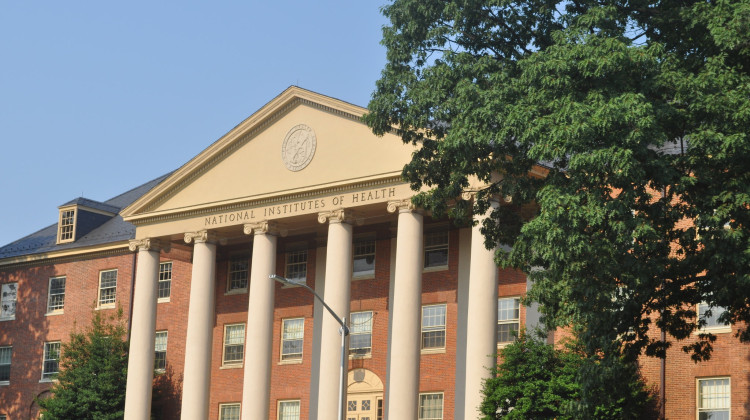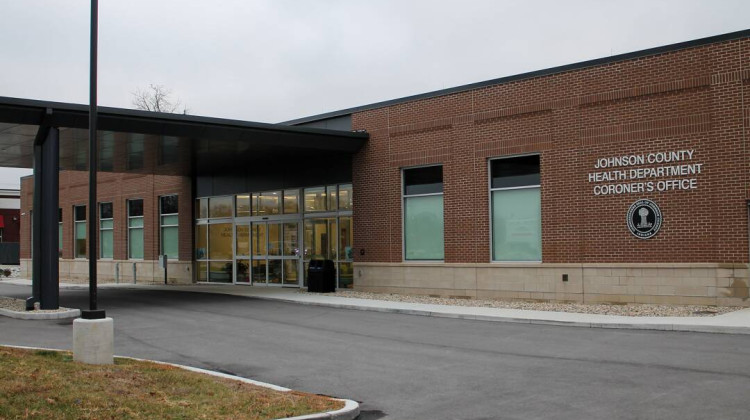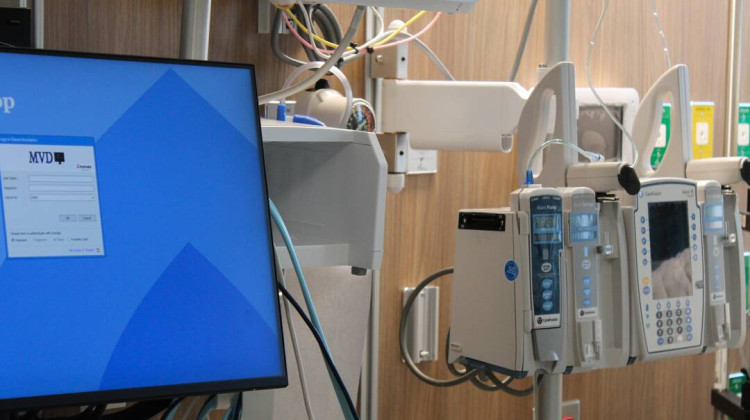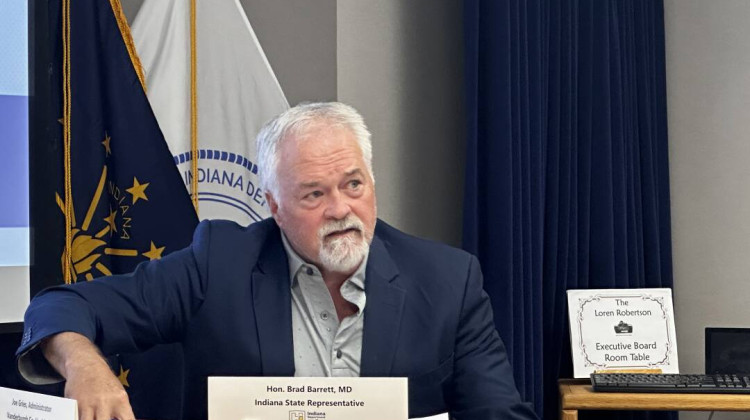
James H. Shannon Building (Building One), NIH campus, Bethesda, MD
Lydia Polimeni / National Institutes of HealthA federal judge on Monday night temporarily stopped plans by the National Institutes of Health to cut funding to universities, hospitals and other research centers across the U.S., including in Indiana.
The temporary pause came after a number of lawsuits including one by the Association of American Medical Colleges and another by 22 Democratic attorneys general.
Indiana's research centers and universities have relied on hundreds of millions of dollars from the federal government to fuel a wide portfolio of basic science and clinical research projects for years.
Now, some researchers worry the funding cuts by the NIH –– the country’s foremost funder of cutting-edge biomedical research –– would impact Indiana’s scientific research capabilities, jobs, and economy.
The cuts come as an attempt from the current administration to reduce federal spending. Proponents of the move say this has been a long time coming. Similar cuts were mulled during President Donald Trump’s first term.
“The announcement that NIH made does not represent a cut in funding for medical research,” said Jay Greene, a research fellow at the Center for Education Policy at the Heritage Foundation, which was behind the Project 2025 conservative policy blueprint.
“If anything, it actually will result in an increase in funding for research because it reduces the amount that is being spent on overhead.”
The NIH’s cuts take aim at what’s known as “indirect research costs” –– which fund institutions’ overhead, lab upkeep, and other administrative expenses. Indirect costs are calculated as a percentage of the direct research costs granted, with each institution individually negotiating indirect research cost rates with the federal government.
Indiana University asks for 58.5% on top to cover indirect costs for on-campus research projects, and 26% for off-campus research projects. This means that for every dollar IU gets for on-campus research, it would spend another 58.5 cents on overhead.
The NIH’s new decision aimed to limit that percentage to just 15%, which could save taxpayers $4 billion, according to the federal agency’s post on X. The decision would impact any new grants issued and all existing grants “for go forward expenses from February 10, 2025,” according to the NIH.
Experts said this would practically mean a significant budget cut to every institution that does biomedical research across the country. Many worry that this would blunt America’s scientific edge, delay medical advances and steer young, promising talent away from academia to industry, or even foreign countries with scientific research infrastructure.
“Slashing NIH funding is dangerous and short-sighted, no matter which way you look at it,” said Indiana Democratic Congressman André Carson.
“Yet now, instead of speaking up to protect investments that help all Americans, Republicans are bowing to Elon Musk and silently allowing him to line billionaires’ pockets instead of helping sick kids. It’s unconscionable."
Unintended consequences
In 2024, the Midwest states of Indiana, Iowa, Ohio, Missouri, Illinois, Kentucky and Kansas received a total amount of more than $4.5 billion in NIH funding.
For example, Indiana-based institutions received more than $407 million in NIH funding – of those $111 million were for indirect research costs.
If the new NIH-proposed 15% cap goes into effect, Indiana’s major universities stand to lose millions of dollars every year.
Side Effects Public Media reached out to Notre Dame University, Purdue University and Indiana University for comment but they all declined to give an interview.
Some veteran researchers say that these cuts will not necessarily stop most research projects but they would have a chilling effect.
Timothy Richardson is a senior research professor at Indiana University School of Medicine who leads a federally-funded drug discovery center for Alzheimer’s Disease treatments. He moved from the pharmaceutical giant Eli Lilly to join the school of medicine because of his deep interest in basic scientific research –– the kind that is not always attractive to for-profit pharma companies since it takes many years before yielding breakthroughs that translate into profit.
“It takes about 20 years of incubation and academia before Big Pharma even picks up a project,” he said. “If you're taking funding away from academics, you're not going to be able to fund research that has a really long time horizon.”
Those indirect costs help sustain these marathon-type research projects that ultimately change the face of medical care as we know it, he said.
“Obviously, Indiana University will have to change its budget allocations,” he said. “I would assume that the state of Indiana would want to continue investing in the flagship universities, so I would assume that budget shortfalls would eventually end up rolling up into the state budgets.”
Greene of the Heritage Foundation disagrees.
He said he doesn’t see any scenario where states will end up footing the bill. Instead, he said, universities will just have to find more efficient ways to conduct research and disburse administrative expenses, or they’d need to find ways to itemize those expenses to be included in their grant proposals as direct research costs.
Richardson said a standard R01 grant –– one of the most competitive grants awarded by the NIH –– pays for a percentage of his salary, and the salary of a postdoctoral researcher, in addition to supplies and equipment. But there is a host of additional administrative supports necessary for his research operation that the federal government does not allow him to tack on to the direct costs portion of the grant.
“I could envision NIH allowing me to put, say, an administrative cost as a direct line in the budget, but obviously they would have to increase the overall amount per grant or I would have to reduce the amount of scientific research that can be accomplished,” Richardson said.
Trump's negotiation strategy
The decision to cut NIH funding was announced on Friday and briefly went into effect on Monday, sending shockwaves across the scientific community.
If not on its merits, the decision has been criticized for a confusing and chaotic rollout, experts said.
But some in the conservative circles said that is just President Trump’s style of negotiation.
“I think that he tries to make a position favorable to his priorities clear, and then see if he can force people to come as close to his priorities as possible,” Greene of the Heritage Foundation said, “and that is unpleasant for the people on the other side of that negotiation, but it's not clear that that's a less effective or ultimately [less] optimal way of negotiating.”
He said that this is the Trump administration’s effort to force a conversation around the “true rate” of indirect research costs.
In its Friday announcement, the NIH said that the funding cap brings the indirect cost rate in line with what universities accept from private foundations and donors.
“For example, a recent study found that the most common rate of indirect rate reimbursement by foundations was 0%, meaning many foundations do not fund indirect costs whatsoever,” according to NIH’s announcement.
“In addition, many of the nation’s largest funders of research — such as the Bill and Melinda Gates Foundation — have a maximum indirect rate of 15%. And in the case of the Gates Foundation, the maximum indirect costs rate is 10% for institutions of higher education.”
But private foundations allow researchers to include certain expenses as direct research costs that the federal government would not, according to reporting from STAT News, which means this is not an apples-to-apples comparison.
Greene of the Heritage Foundation said that he understands researchers and university staff are “trying to do good things” but added that they’re also not forthcoming with their indirect research costs and how they spend that money.
“[Universities] have incentives to go as high as they can get away with. Again, not out of evil motivation, but out of self-interested motivation like normal people have,” Greene said. “From the perspective of taxpayers, however, that's not good, because, sure, taxpayers benefit from research, but they also don't want to overpay for it, and if they significantly overpay for it, then they're being ripped off.”
But some experts point to the economic impact that NIH funding has on state economies. For example, in 2023, Indiana received around $414 million in NIH grants. That supported 5,359 jobs and generated $1.1 billion in economic activity in the state, according to a report from the nonprofit United for Medical Research. This is in addition to supporting cutting-edge research critical to people’s health and medical advancement.
“The U.S. government –– through the NIH –– funded the war on cancer, cardiovascular disease, dyslipidemia, diabetes, HIV,” Richardson said. “These are manageable diseases now, and they are because the government invested in research.”
Richardson worries that the abrupt cuts, though aimed at efficiency, could have unintended consequences derailing scientific advancement. He said some of the cuts remind him of his time working in the private sector.
“When someone new came in who didn't quite understand how the business worked and made changes,” he said. “Particularly changes that are quote-unquote efficiency or cost reduction changes, where there are unintended consequences because leadership just doesn't understand the effects of the decisions that they've made.”
This story was updated at 10:54 pm ET to include a statement from Congressman André Carson.
Side Effects Public Media is a health reporting collaboration based at WFYI in Indianapolis. We partner with NPR stations across the Midwest and surrounding areas — including KBIA and KCUR in Missouri, Iowa Public Radio, Ideastream in Ohio and WFPL in Kentucky.
 DONATE
DONATE






 Support WFYI. We can't do it without you.
Support WFYI. We can't do it without you.